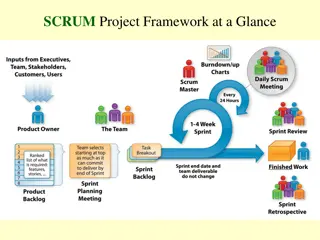
The Role of Agile Estimation Techniques in Scrum
Agile estimation techniques play a crucial role in helping Scrum teams forecast the effort required for user stories, tasks, or entire sprints.
Download Presentation

Please find below an Image/Link to download the presentation.
The content on the website is provided AS IS for your information and personal use only. It may not be sold, licensed, or shared on other websites without obtaining consent from the author. If you encounter any issues during the download, it is possible that the publisher has removed the file from their server.
You are allowed to download the files provided on this website for personal or commercial use, subject to the condition that they are used lawfully. All files are the property of their respective owners.
The content on the website is provided AS IS for your information and personal use only. It may not be sold, licensed, or shared on other websites without obtaining consent from the author.
E N D
Presentation Transcript
The Role of Agile Estimation Techniques in Scrum In the Scrum framework, successful project management relies heavily on accurate estimation. Agile estimation techniques play a crucial role in helping Scrum teams forecast the effort required for user stories, tasks, or entire sprints. Estimating work accurately allows teams to plan effectively, set realistic goals, and ensure they deliver valuable increments to stakeholders. This blog will explore the importance of Agile estimation techniques in Scrum and the most commonly used methods. Why Estimation Matters in Scrum In Scrum, estimation serves multiple purposes: 1.Sprint Planning: Estimations help teams understand the effort needed to complete tasks within a sprint. Without proper estimation, teams may either overestimate or underestimate, leading to incomplete sprints or burnout. 2.Capacity Management: Scrum teams have a limited amount of time and resources in each sprint. Estimation helps allocate these resources efficiently by matching the work to the team s capacity. 3.Transparency and Communication: Estimating tasks provides stakeholders with an understanding of the project's progress and timeline. It helps them set realistic expectations and makes sure the team is aligned with the product's goals. 4.Continuous Improvement: Estimation in Scrum encourages teams to learn from previous sprints and improve future estimates, ultimately boosting their accuracy over time. Common Agile Estimation Techniques in Scrum Several estimation techniques are commonly used in Scrum. These techniques ensure that the team estimates work in a way that is both efficient and aligned with Agile principles. Here are the most popular ones: 1. Planning Poker Planning Poker is one of the most widely used Agile estimation techniques in Scrum. It s an interactive and collaborative method where team members estimate tasks by playing numbered cards that correspond to the estimated effort required. How It Works: The Scrum Master or Product Owner presents a user story or task to the team. Each team member privately selects a card representing their estimate. Once all cards are revealed, the team discusses the estimates, especially any large discrepancies. The process is repeated until consensus is reached. Why It s Effective: Planning Poker fosters collaboration and encourages team members to voice their opinions, ensuring that estimates are well-rounded and reflective of the team's collective understanding of the work. 2. T-Shirt Sizing
T-shirt Sizing is a simpler, high-level estimation technique. It categorizes tasks into different sizes, typically Small, Medium, Large, and Extra Large, based on effort and complexity. How It Works: The team reviews the user stories and assigns each one a size based on its relative complexity. For example, a "Small" task might take a few hours, while an "Extra Large" task could span multiple days or weeks. Why It s Effective: T-shirt sizing provides a quick and straightforward way to group tasks by effort, making it useful for initial estimation when detailed information might not be available. 3. Fibonacci Sequence The Fibonacci Sequence is another popular Agile estimation technique in Scrum, which assigns point values based on the Fibonacci sequence (1, 2, 3, 5, 8, 13, etc.). This helps in estimating tasks that vary in complexity and size. How It Works: The Scrum team assigns each user story a point value from the Fibonacci sequence. Smaller tasks may be assigned 1 or 2 points, while more complex tasks could be assigned 8 or 13 points. The exponential nature of the Fibonacci sequence helps emphasize the increasing uncertainty of larger tasks. Why It s Effective: The Fibonacci Sequence helps teams avoid underestimating larger tasks and allows for more nuanced estimation of effort. It also accounts for the inherent uncertainty in larger or more complex tasks. 4. Bucket System The Bucket System is a time-efficient estimation technique ideal for large backlogs that need to be estimated quickly. It helps teams categorize user stories into buckets based on their size. How It Works: The team creates a set of buckets, each representing a point value (e.g., 1, 2, 5, 8, etc.). Team members place each user story into the corresponding bucket that they believe matches the story s effort. Why It s Effective: This system allows for fast estimation of many stories, making it an efficient technique for large projects with extensive backlogs. Benefits of Agile Estimation Techniques 1.Improved Accuracy: Estimation techniques improve the accuracy of effort predictions, helping teams deliver on time and meet sprint goals. 2.Better Team Collaboration: Estimating together fosters teamwork, as it requires everyone to contribute their knowledge and perspective. 3.Enhanced Transparency: Estimations give stakeholders a clearer view of the team's progress, risks, and timelines, increasing trust and alignment. 4.Informed Decision-Making: Well-estimated tasks help the Product Owner make informed decisions about priorities, ensuring that the most valuable work is completed first.
Conclusion Agile estimation techniques play a pivotal role in the Scrum framework, allowing teams to plan sprints, allocate resources, and manage expectations effectively. Whether using Planning Poker, T-shirt Sizing, the Fibonacci Sequence, or the Bucket System, these techniques help teams estimate more accurately and collaborate more efficiently. As Scrum continues to evolve, the role of estimation will remain a cornerstone of Agile development, driving productivity and successful project outcomes. Read techniques.html More: https://techhorizonsolutions.blogspot.com/2024/09/the-role-of-agile-estimation-






















